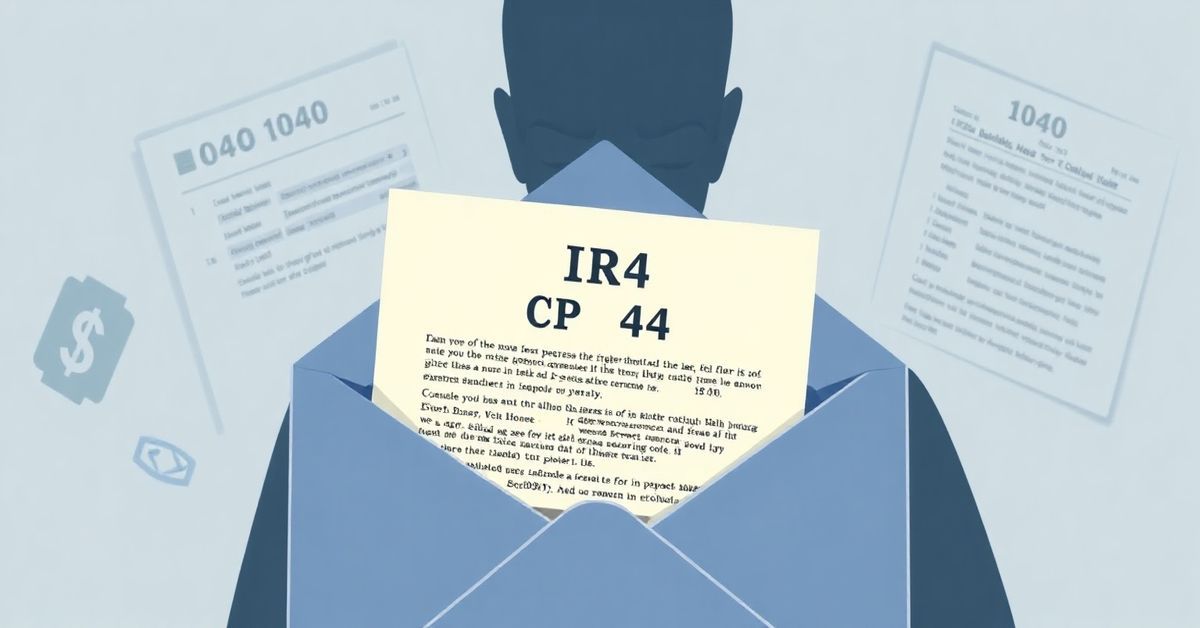Understanding the CP44 Notice: What It Really Means
Have you ever been excited about a tax refund, only to find out it’s not coming as planned? If you’ve received a CP44 notice from the IRS, that’s exactly what’s happening. It can be a bit confusing, so let’s break it down simply. The IRS sends this notice when they are holding your current refund to pay off unpaid taxes from past years. Think of it as the IRS using your current refund to catch up on what you still owe them.
Why Did I Get a CP44 Notice?
The Core Reason: Unpaid Back Taxes
The CP44 notice boils down to one main reason: you have unpaid tax liabilities from previous years. This could be from income taxes, self-employment taxes, or even penalties and interest. If the IRS records indicate that you still owe money, they might hold your refund. This is how they ensure they get their money, and it’s known as an “offset”.
Other Potential Triggers
While past-due taxes are the most common reason, there could be a few other situations that might lead to a CP44 notice. For instance:
- Unpaid Penalties or Interest: Sometimes, it isn’t the tax itself but penalties or interest added to your bill.
- Errors on a Previous Return: If an error was found on an older return and you owe money, they might use this strategy.
- State Tax Debts: In some cases, the IRS might offset your federal refund to satisfy debts you owe to a state government for taxes or other obligations.
How Does the IRS “Offset” My Refund?
The IRS’s Right to Offset
When you owe money to the IRS, they have the authority to use any federal payments (including your tax refund) to settle that debt. It’s a legal process designed to ensure tax debts are paid. This is known as an “offset” because they are offsetting your refund against what you owe.
The Process Explained
- The Delinquent Tax: First, the IRS identifies that you have past-due taxes.
- Match with Current Refund: Then, when you file a current year’s tax return and are due a refund, the IRS matches it to your past due debt.
- Offset Happens: The IRS will keep some or all of your refund to cover your overdue debt.
- You Receive the CP44: Finally, the IRS sends you a CP44 notice to tell you that they’ve done this and explain the details.
What Does the CP44 Notice Tell Me?
Key Information to Look For
The CP44 notice includes essential details about the offset and your tax situation. Make sure you carefully review the following:
- Tax Year of the Debt: It will specify the tax year or years for which you owe money.
- Amount of the Debt: The exact amount of unpaid taxes, penalties, and interest will be listed.
- Amount of the Offset: The portion of your refund used to pay the debt.
- Your Rights: You’ll be reminded of your rights, such as the right to challenge the debt.
- Contact Information: Details about whom to contact if you have questions or believe there’s an error.
- Payment Options The notice will provide information on how to pay the remaining amount due if the refund wasn’t enough to cover it.
Why It’s Important to Read Carefully
It is very important to carefully review the CP44 notice to fully understand the situation and know your next steps. Don’t just put it aside. Knowing the specifics of the debt can help you take action to resolve it.
Who is Affected by a CP44 Notice?
Anyone who has overdue tax debts is at risk of receiving this type of notice if they are due a tax refund. This includes:
- Individuals: If you have filed past tax returns and owe taxes.
- Business Owners: If your business owes back taxes.
- Self-Employed Individuals: Those with unpaid self-employment taxes.
It’s not limited to a particular income group or profession. If you have any tax debt, you could be impacted by a CP44 notice.
What To Do When You Receive a CP44 Notice
1. Don’t Panic
First, don’t panic. While getting a notice about your refund being held can be upsetting, it’s important to stay calm and take the right steps. This isn’t something you can ignore, but it is also something that can be resolved.
2. Verify the Information
Carefully review the information on the CP44 notice and compare it with your own tax records. Make sure the tax year, amount of the debt, and the offset amount are correct.
3. Address the Unpaid Debt
This is the most important step. Determine the best way to settle your unpaid tax debt. Here are your options:
- Pay the Balance: If you can, pay the remaining balance immediately to avoid further penalties and interest. The notice will tell you how to make the payment.
- Installment Agreement: If you can’t afford to pay the full amount at once, contact the IRS to set up an installment agreement. This allows you to pay off your debt over time.
- Offer in Compromise (OIC): In very specific cases, you might qualify for an OIC, which allows you to settle your tax debt for less than the full amount you owe. This is usually for those in significant financial hardship.
- Tax Professional: If the tax laws are confusing, seek the assistance of a tax professional to help you understand your situation. They can offer customized solutions for you and help you make the best decision.
4. If You Disagree with the Notice
If you believe the CP44 notice is incorrect or you don’t owe the debt, contact the IRS immediately. Have all the documentation you can to help show your side. Be prepared to provide:
- Proof of Payment: If you’ve already paid, show proof of payment.
- Corrected Return: If you believe the tax liability is wrong, file an amended return with the correct information.
- Documentation: Any other relevant documentation supporting your claim.
Common Mistakes and Misconceptions
Myth: A CP44 Notice Means I’m Being Audited
Receiving a CP44 notice doesn’t mean you’re being audited. It simply indicates you have an outstanding debt and the IRS is using the refund as payment.
Mistake: Ignoring the Notice
Ignoring the notice won’t make the debt go away. Unpaid tax debts can grow with penalties and interest. It’s important to address the situation as soon as possible.
Misconception: All My Refund Will Be Taken
The IRS will only take what you owe. If your refund is more than what you owe, you’ll receive the difference. If your refund is less than the amount you owe, you are still liable to pay that difference.
Tips to Avoid Future CP44 Notices
File Your Taxes on Time
One of the easiest ways to avoid tax problems is to file your taxes on time every year. Even if you can’t pay what you owe, still file by the deadline to avoid late filing penalties.
Pay Taxes Owed When They Are Due
If you cannot pay in full, pay as much as you can when they are due. This reduces penalties and interest as you owe less from the start.
Keep Good Records
Keep thorough records of your tax documents. This makes it easier to file correctly and handle any IRS inquiries.
Regularly Check Your Tax Account
The IRS has an online system to check what you owe them. You can see any outstanding balances and catch issues early.
Seek Professional Help When Needed
A tax professional can provide assistance with your taxes, help you with complicated tax issues, and help you avoid these kinds of issues.
In Conclusion
A CP44 notice indicates that your tax refund is being held to cover a previous debt to the IRS. Knowing what it means, what to do, and how to avoid it is critical for maintaining a healthy tax standing. By paying attention to your tax obligations and responding promptly to IRS notices, you can ensure that you’re handling your taxes correctly and avoiding future issues. Stay on top of your taxes and don’t hesitate to reach out for help when you need it.

